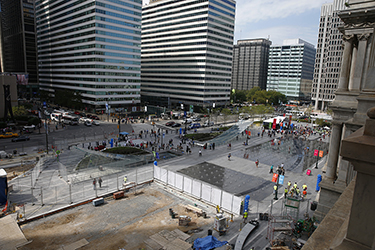|
Subscribe / Renew |
|
|
Contact Us |
|
| ► Subscribe to our Free Weekly Newsletter | |
| home | Welcome, sign in or click here to subscribe. | login |
Architecture & Engineering
| |
September 24, 2014
$55M park gives Philly a new heart
Associated Press
PHILADELPHIA — William Penn — the one in bronze — might be standing a little taller these days from his perch atop Philadelphia's mammoth City Hall.
A bleak, maze-like plaza of granite and concrete in the shadow of the ornate stone-and-brick structure — the country's largest municipal building — has undergone a $55 million transformation that officials say is more in line with the city founder's original vision for the square.
Dilworth Plaza is becoming the 120,000-square-foot Dilworth Park, complete with a great lawn, groves of trees, a programmable water fountain, an upscale cafe and — in the winter — an ice rink. Officials hope the transformation will make the area around City Hall, which sits in a traffic circle of sorts in the intersection of the city's two main thoroughfares, Market and Broad streets, an attractive gathering place instead of a homeless hangout.
After more than two years of construction, the park is open now and scheduled for a regular program of activities. Dilworth will host picnics, dance parties, concerts, movie screenings and pop-up boutiques. Next month, an Octoberfest beer garden will pop up.
Penn's 1600s vision of “Center Square” as a hub of society, commerce and culture also called for public buildings, but City Hall didn't go up until about 200 years later.
Dilworth Plaza, named for former Mayor Richardson Dilworth and completed in the late 1970s, soon disappointed.
Paul Levy, chief executive of the private business improvement district, which managed the project, said the plaza was long seen as a “failed public space,” a well-intentioned effort that was typical of design at the time.
“It was just a place you walked through,” said Bill Quinn, 55, of Philadelphia, as workmen put on finishing touches Wednesday.
“Dreary-looking,” is how Sandra Epps, 46, also of Philadelphia, described the old plaza, which spent its final days before the transformation hosting Occupy Philadelphia protesters who were evicted ahead of the start of construction.
Much of the new work occurred underground, with new entrances and better lighting for transit lines serving the area. A concourse level was reconstructed for easier navigation, with new signs to orient passengers and two LCD panels showing information on trolley routes.
City officials hope the new park will also increase the number of people touring City Hall, which features nearly 700 rooms and more than 250 sculptures by Alexander Milne Calder.
Adult tourists now pay $12 to tour the entire inside of the building or $6 to just ride a small elevator to an observation deck that sits about 40 stories above ground, just below the 37-foot Penn statue perched atop the clock tower.
Three Philadelphia-based firms, KieranTimberlake architects, OLIN landscape architects and Urban Engineers Inc., designed the transformation.
Steve Ricchini, who operates a newsstand across from the park, said he hopes it becomes a major draw, but said its success hinges on how the city manages the homeless that used to stay in the plaza.
“It looks great so far,” Ricchini said. “Only time will tell. It all depends on what kind of security they have over there.”
The park is not completed. Delays because of a severe winter means the lawn and walkways won't be finished until October.



